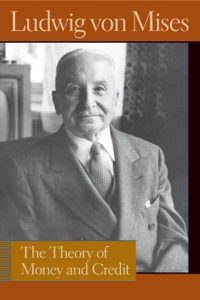The Theory of Money and Credit
By Ludwig Mises
Ludwig von Mises (1881-1973) first published
The Theory of Money and Credit in German, in 1912. The edition presented here is that published by Liberty Fund in 1980, which was translated from the German by H. E. Batson originally in 1934, with additions in 1953. Only a few corrections of obvious typos were made for this website edition. One character substitution has been made: the ordinary character “C” has been substituted for the “checked C” in the name Cuhel.
Translator/Editor
H. E. Batson, trans.
First Pub. Date
1912
Publisher
Indianapolis, IN: Liberty Fund, Inc. Liberty Classics
Pub. Date
1981
Comments
First published in German. Foreword by Murray Rothbard and Introduction by Lionel Robbins not available online
Copyright
The text of this edition is under copyright. Picture of Ludwig von Mises: file photo, Liberty Fund, Inc.
- Foreword
- Preface
- Introduction
- Historical Prefaces
- Part I,Ch.1
- Part I,Ch.2
- Part I,Ch.3
- Part I,Ch.4
- Part I,Ch.5
- Part I,Ch.6
- Part II,Ch.7
- Part II,Ch.8
- Part II,Ch.9
- Part II,Ch.10
- Part II,Ch.11
- Part II,Ch.12
- Part II,Ch.13
- Part II,Ch.14
- Part III,Ch.15
- Part III,Ch.16
- Part III,Ch.17
- Part III,Ch.18
- Part III,Ch.19
- Part III,Ch.20
- Part IV,Ch.21
- Part IV,Ch.22
- Part IV,Ch.23
- Appendix A
- Appendix B
- Bio
- Dem
Translator’s Note on the Translation of Certain Technical Terms
APPENDIX B
It is never possible to be certain that the full significance of a technical term has been brought out in a translation. A short list of the original German terms for the kinds of money and money substitutes mentioned in the present work, and of the English expressions which have been used to translate them, is therefore appended.
The word
Umlaufsmittel presented a peculiarly difficult problem. There is no established English equivalent for the sense in which Professor Mises uses the term. “Circulating medium,” the literal translation, is clearly inappropriate, for it suggests associations with currency which are quite foreign to Professor Mises’ meaning. “Bank money” is inadequate, for
Umlaufsmittel includes, not merely bank deposits, but also money substitutes issued by the state (such as token money). “Credit instrument,” which at first sight might appear satisfactory, is inconsistent with Professor Mises’ insistence on the difference between
Umlaufsmitteln and bills of exchange; and, furthermore, Professor Mises explicitly argues that the issue of
Umlaufsmitteln is not a credit transaction in the more fundamental sense. For want of a better equivalent, therefore, the expression “fiduciary medium” has been adopted. It accords with Professor Mises’ definition of
Umlaufsmitteln as money substitutes not covered by money,
*52 and it evokes associations with the controversies about the Peel Act of 1844 that are in harmony with Professor Mises’ attitude. It also draws attention to Professor Mises’ emphasis upon the similarity between uncovered bank deposits and uncovered notes.
The following equivalents for other technical terms have also been adopted:
*53
Money in the broader sense (
Geld im weiteren Sinne)
Money in the narrower sense (
Geld im engeren Sinne)
Money substitute (
Geldsurrogat)
Commodity money (
Sachgeld)
Credit money (
Kreditgeld)
Fiat money (
Zeichengeld)
Token money (
Scheidemünzen)
Money certificate (
Geldzertifikat)
Commodity credit (
Sachkredit)
Circulation credit (
Zirkulationskredit)
The following diagram shows the relationships between some of these terms in Professor Mises’ system:


